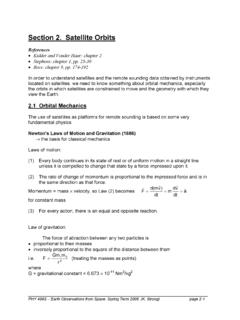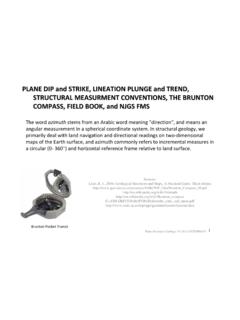Transcription of Section 2. Satellite Orbits - Earth, Atmospheric, and ...
1 Section 2. Satellite Orbits References Kidder and Vonder Haar: chapter 2. Stephens: chapter 1, pp. 25-30. Rees: chapter 9, pp. 174-192. In order to understand satellites and the remote sounding data obtained by instruments located on satellites, we need to know something about orbital mechanics, especially the Orbits in which satellites are constrained to move and the geometry with which they view the earth . Orbital Mechanics The use of satellites as platforms for remote sounding is based on some very fundamental physics. Newton's Laws of Motion and Gravitation (1686). the basis for classical mechanics Laws of motion: (1) Every body continues in its state of rest or of uniform motion in a straight line unless it is compelled to change that state by a force impressed upon it. (2) The rate of change of momentum is proportional to the impressed force and is in the same direction as that force.
2 D(mv ) . dv . Momentum = mass velocity, so Law (2) becomes F= =m =a dt dt for constant mass (3) For every action, there is an equal and opposite reaction. Law of gravitation: The force of attraction between any two particles is proportional to their masses inversely proportional to the square of the distance between them Gm 1m 2. F= (treating the masses as points). r2. where -11 2 2. G = gravitational constant = 10 Nm /kg _____. PHY 499S earth Observations from Space, Spring Term 2005 (K. Strong) page 2-1. These laws explain how a Satellite stays in orbit . Law (1): A Satellite would tend to go off in a straight line if no force were applied to it. Law (2): An attractive force makes the Satellite deviate from a straight line and orbit earth . Law of Gravitation: This attractive force is the gravitational force between earth and the Satellite .
3 Gravity provides the inward pull that keeps the Satellite in orbit . Assuming a circular orbit , the gravitational force must equal the centripetal force. mv 2 Gmm E. =. r r2. where v = tangential velocity r = orbit radius = RE + h ( not the altitude of the orbit ). RE = radius of earth h = altitude of orbit = height above earth 's surface m = mass of Satellite mE = mass of earth GmE. v= , so v depends only on the altitude of the orbit (not on the Satellite 's mass). r 2 r r r3. The period of the Satellite 's orbit is T = = 2 r = 2 . v Gm E Gm E. Again, this is only dependent on the altitude, increasing as the orbit 's altitude increases. v v t v v2. The acceleration of the Satellite is determined using v . r , so a = lim t 0 t =. r . r v t r v r v r F. m . m v E r v'. v'. v _____. PHY 499S earth Observations from Space, Spring Term 2005 (K.)
4 Strong) page 2-2. Example: The Odin Satellite will orbit at ~600 km. r = 600 + RE = 600 + 6378 ( earth 's equatorial radius) = 6978 km ( 10 11 Nm 2 / kg 2 ) ( 10 24 kg). v = = 7558 m/s ~ km/s 6978 10 3 m T = 5801 s = min Conversely, we can use these equations to calculate the altitude a Satellite in geosynchronous orbit . the higher the Satellite the longer the period of its orbit so moving it high enough will make its orbit match earth 's rotation rate 2. T . r = 3 Gm E = 42,166 km, so altitude above surface = 35,788 km 2 . where T = 86, s = sidereal day, the period of earth 's rotation with respect to the stars. Kepler's Laws for Orbits So far, we have assumed that satellites travel in circular Orbits , but this is not necessarily true in practice. Newton's Laws can be used to derive the exact form of a Satellite 's orbit .
5 However, a simpler approach is to look at Kepler's Laws, which summarize the results of the full derivation. Kepler's Laws (1609 for 1,2; 1619 for 3) were based on observations of the motions of planets. (1) All planets travel in elliptical Orbits with the Sun at one focus. defines the shape of Orbits (2) The radius from the Sun to the planet sweeps out equal areas in equal times. determines how orbital position varies in time (3) The square of the period of a planet's revolution is proportional to the cube of its semimajor axis. suggests that there is some systematic factor at work For satellites, substitute Satellite for planet, and earth for Sun. See figure ( 94 ) Kepler's law of equal areas _____. PHY 499S earth Observations from Space, Spring Term 2005 (K. Strong) page 2-3. Ellipse Geometry and Definitions See figure (K&VH ) - elliptical orbit geometry Some geometric terms: perigee - point on the orbit where the Satellite is closest to earth apogee - point on the orbit where the Satellite is furthest from earth semimajor axis - distance from the centre of the ellipse to the apogee or perigee (a).
6 Semiminor axis (b). eccentricity - distance from the centre of the ellipse to one focus / semimajor axis ( ). =c/a (Note: c is a in K&VH Figure ). 0 <1. = 0 for a circle Can also show that a2 = b2 + c 2 or b = a 1 2 . Recall the equation describing an ellipse which is centred at the origin of the x-y plane: x2 y 2. + = 1 , with a > b > 0. a2 b 2. However, it is more convenient to move the co-ordinate system such that the origin is at the focus ( , the earth ), so that x = xp + c y = yp We can show (!) that the equation for the ellipse, when converted to polar co-ordinates with the earth at the origin becomes a(1 2 ). r=. 1 + cos . where r = distance from the Satellite to the centre of earth = the true anomaly, and is always measured counterclockwise from the perigee. At perigee, = 0 so r = rperigee = a(1 ).
7 At apogee, = so r = rapogee = a(1 + ) . This equation describes the shape of the orbit , but not the dynamics of the Satellite motion, , we want to find (t). _____. PHY 499S earth Observations from Space, Spring Term 2005 (K. Strong) page 2-4. Kepler's Time of Flight Equation A Satellite in a circular orbit has a uniform angular velocity. However, a Satellite in an elliptical orbit must travel faster when it is closer to earth . It can be shown that a more general expression for the velocity of an orbiting Satellite is 2 1 . v = Gm E . r a . where the mass of the Satellite is negligible relative to the mass of earth . Kepler's Second Law can be applied (non-trivial) to calculate the position of a Satellite in an elliptical orbit as a function of time. This introduces a new term, the eccentric anomaly, e , which is defined by circumscribing the elliptical orbit inside a circle.
8 See figure (K&VH ) - geometric relation between e and . Time of flight equation: e sin e = n( t t p ) M. where e = eccentric anomaly = eccentricity M = the mean anomaly t = time tp= time of perigee passage (when = 0). 2 GmE. n = = = mean motion constant T a3. The eccentric anomaly and the true anomaly are geometrically related by cos e cos + . cos = and cos e = . 1 cos e 1 + cos . Can solve for e(t) and hence (t) and r(t). _____. PHY 499S earth Observations from Space, Spring Term 2005 (K. Strong) page 2-5. Co-Ordinate Systems Thus far, we have derived expressions for and r as functions of time from a consideration of Newton's and Kepler's Laws. A more rigorous treatment would involve applying Newton's Laws to derive the equations for two-body motion. These equations could then be simplified by assuming msatellite< mE (for which Kepler's Laws are exact).
9 Using a reference frame with the origin at the earth (effectively an inertial frame). Right Ascension-Declination System Now we have (t) and r(t) which position the Satellite in the plane of the orbit . Next, we need to establish a co-ordinate system to position the orbital plane in space. Introduce the right ascension-declination co-ordinate system (common in astronomy). z axis is aligned with earth 's spin axis x axis points from the centre of the earth to the Sun at the vernal equinox position ( , when the Sun crosses the equatorial plane from the Southern to the Northern hemisphere). y axis is chosen to make it a right-handed system See figure (K&VH ) - right ascension-declination co-ordinate system Note: the Sun's apparent path is called the ecliptic. The obliquity of the ecliptic is , the same angle as the tilt of the earth 's axis.
10 Then we can define: declination ( ). is the angular displacement of a point in space measured northward from the equatorial plane right ascension ( ). is the angular displacement, measured counterclockwise from the x axis, of the projection of the point onto the equatorial plane The - system is analogous to latitude and longitude, with ~ latitude, giving angular distance north or south of the celestial equator ~ longitude, giving angular distance measured eastward from a reference point on the celestial equator ( , from the vernal equinox). See figure (K&VH ) - definition of right ascension and declination See figure (K&VH ) - angles used to orient an orbit in space (for next Section ). See figure ( 95 ) astronomical coordinate system _____. PHY 499S earth Observations from Space, Spring Term 2005 (K.)






